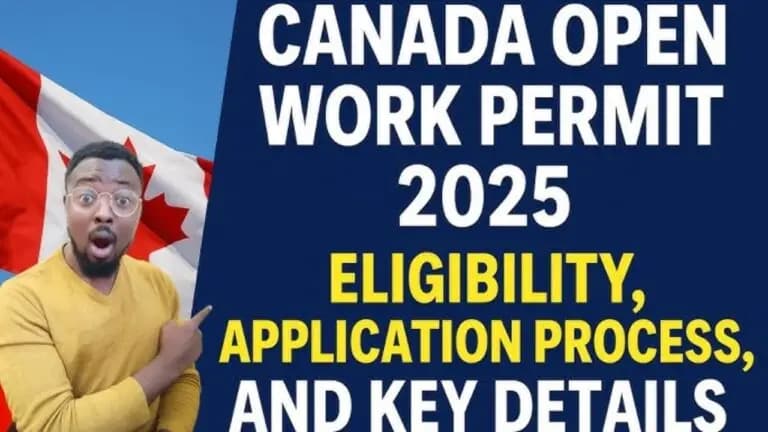Are you dreaming of starting a job in Canada without being tied to a specific employer? Then an Open Work Permit (OWP) may be your best route to flexibility, freedom, and opportunity in one of the world’s most immigrant-friendly countries.
In this post, we’ll explore the August 2025 updates to Canada’s open work permit system, highlighting who is eligible, what has changed, how to apply, and how long it may take.
🧾 What is an Open Work Permit?
A Canadian Open Work Permit allows foreign nationals to work for any employer in Canada without needing a specific job offer at the time of application. This differs from employer-specific permits which restrict you to a single company or job role.
The OWP is ideal for:
-
Spouses or partners of eligible workers or students
-
International graduates (PGWP)
-
Refugees and vulnerable workers
-
Those transitioning to permanent residency
-
International Experience Canada (IEC) applicants
🚨 August 2025 Key Changes You Should Know
In 2025, Canada introduced significant updates to who qualifies for an Open Work Permit—especially for international students’ spouses and skilled worker dependents. Here’s a breakdown:
✅ Who Is Eligible (as of August 2025)?
-
Spouses or Common-Law Partners of Eligible Foreign Workers:
-
Your spouse must work in a TEER 0 or 1 role (high-skilled) OR in select TEER 2/3 jobs in high-demand sectors like healthcare, education, and construction.
-
Your spouse’s work permit must have 16 months or more left.
-
-
Spouses of Master’s, PhD, or Professional Program Students:
-
If your partner is enrolled in a Master’s, PhD, or professional program (like medicine or law), you may be eligible.
-
-
Post-Graduation Work Permit (PGWP) Holders:
-
Recent graduates from Canadian institutions can apply for an open work permit to gain Canadian work experience.
-
-
Permanent Residence Applicants (Bridging Open Work Permit – BOWP):
-
If you’ve applied for PR under eligible programs (e.g., Express Entry), you can apply for a BOWP while awaiting results.
-
-
IEC Participants and Vulnerable Workers:
-
IEC (International Experience Canada) applicants can work freely if approved.
-
Vulnerable foreign workers facing abuse or exploitation also qualify.
-
❌ Who Is No Longer Eligible?
As of January 2025:
-
Spouses of diploma or certificate students are no longer eligible for OWPs.
-
Dependent children of workers or students are excluded from OWP eligibility.
-
Spouses of students in non-degree programs are now disqualified under the new rules.
💰 Work Permit Cost and Processing Time
-
Application Fee: CAD 155
-
Open Work Permit Holder Fee: CAD 100
-
Total Cost: CAD 255
Processing time varies:
-
Inside Canada: 8 to 12 weeks
-
Outside Canada: Up to 16 weeks
-
Bridging Permits (BOWP): Apply by Dec 31, 2026
IRCC has started improving digital processing, but backlogs still affect certain categories.
🧳 How to Apply for a Canada Open Work Permit in 2025
Here’s a step-by-step application guide:
Step 1: Check Your Eligibility
Visit Canada.ca or speak with an immigration consultant to confirm your eligibility based on the new criteria.
Step 2: Prepare Your Documents
You’ll need:
-
Passport
-
Proof of relationship (marriage certificate or proof of common-law)
-
Your spouse’s work or study permit and employment details
-
School enrollment letter (if applicable)
-
Digital photo
-
Medical exams (in some cases)
Step 3: Submit Your Application
-
Apply Online through the IRCC Portal.
-
Forms to use:
-
IMM 5710: If you’re applying from within Canada
-
IMM 1295: If applying from outside Canada
-
Step 4: Pay the Required Fees
Pay the CAD 255 total fee through the online system.
Step 5: Wait for Approval
You may receive:
-
A physical work permit (if applying from inside Canada)
-
A Port of Entry (POE) Letter of Introduction (if applying from abroad)
🆕 Recent Policy Enhancements You Should Know
-
Job Change Flexibility: As of May 2025, foreign workers can now change jobs before a new permit is issued—easing transitions within Canada’s labor market.
-
IEC Permit Renewal: Participants in the IEC program no longer need to exit Canada to renew permits; new permits are mailed directly.
-
Digital Improvements: IRCC is streamlining applications using AI-assisted pre-screening and digital correspondence.
⚠️ Warning: Processing Delays for Some Applicants
Recent reports show a rise in LMIA processing delays (from 58 to 165 days) that have affected work permit applicants and caused status losses for some. If you’re applying through an LMIA route, make sure you act early.
📌 Final Thoughts
Canada’s Open Work Permit remains one of the most accessible and flexible routes to work and live in Canada. However, recent policy changes in 2025 have tightened eligibility, especially for spouses of students. If you qualify under the new rules, take advantage of this opportunity and begin your application as early as possible.
If you’re a job seeker hoping to transition into the Canadian labor market, this is a powerful tool to gain valuable work experience, boost your PR chances, and even explore permanent migration routes.
🔗 Helpful Links
Looking for jobs in Canada with open work permit eligibility? Stay tuned to our job site for updated listings, visa guides, and real-time application tips.
Let us know in the comments if you’d like a post on LMIA-free job offers in Canada or direct PR pathways!

